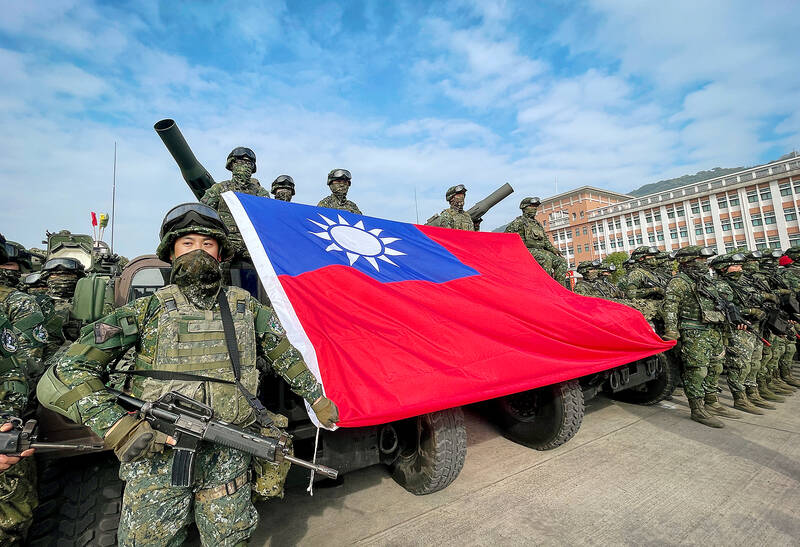A war game by a Japanese think tank simulating a Chinese invasion of Taiwan resulted in a defeat for Beijing, with ghastly losses of troops and equipment on both sides, the Nikkei Asia magazine reported yesterday.
The tabletop simulation conducted by the Sasakawa Peace Foundation envisioned the Chinese People’s Liberation Army (PLA) launching an amphibious attack on Taiwan in 2026 against the combined forces of Taiwan, Japan and the US, it said.
The exercise was conducted over four days through Jan. 21, with close to 30 participants, including retired Japanese military officers, and academics and researchers from the US and Japan, it said.

Photo: CNA
The Chinese offensive failed to seize Taiwan after a two-week struggle that cost the PLA 156 warships, including two aircraft carriers, 168 fighter jets, 48 transport aircraft and more than 40,000 soldiers killed or wounded, it said.
The victory came at a heavy price for the defending forces, who lost more than 26,000 military personnel, scores of warships and hundreds of aircraft, the report said.
The exercise had a PLA command center for the Taiwan front that was capable of deploying all of China’s aircraft, submarines and surface combat capabilities, it said.
In response, the US sent two nuclear-powered aircraft carriers and advanced stealth fighter jets to the theater, while Tokyo permitted the US to operate from Japan Self-Defense Forces bases and civilian airports on Okinawa and Kyushu after invoking a state of emergency, the report said.
After detecting Chinese plans to attack its military bases being used by the US, Japan designated the conflict as an existential threat, prompting Japanese F-35s and warships to join the US in launching missile attacks against the PLA, it said.
The US and Japanese forces overwhelmed China’s, cutting the PLA’s supply lines before seizing control of the airspace over Taiwan in a decisive blow that terminated the battle, it said.
The exercise ended with casualties among Taiwan’s armed forces totaling 13,000 killed, wounded or captured, while 18 warships and 200 warplanes were lost.
The US military’s casualties tallied at 10,700 service members, 19 ships and 400 warplanes, while the Japan Self-Defense Forces lost 15 ships, 144 fighter jets and 2,500 military personnel. Hundreds to 1,000 civilians were killed or wounded by Chinese strikes in Japan, the exercise showed.
Last year, the US-based Center for Strategic and International Studies (CSIS) conducted a series of tabletop exercises on a Taiwan Strait conflict, which found that China was defeated in a majority of the 24 simulations, but at a similarly high cost to the forces of Taiwan, the US and Japan, the report said.
The Sasakawa and CSIS games were predicated on current capabilities and arsenals projected for 2026, so outcomes would differ if the PLA significantly improves its capabilities, it said.
China is rapidly building up its military and some experts believe Beijing is poised to swing the balance of the west Pacific to its favor within two years, the report said, adding that China is also swiftly expanding its nuclear arsenal.
“We must make every possible preparation for substantial losses while we still can,” Tsuneo Watanabe, a senior research fellow at the foundation, was quoted as saying.

US climber Alex Honnold is to attempt to scale Taipei 101 without a rope and harness in a live Netflix special on Jan. 24, the streaming platform announced on Wednesday. Accounting for the time difference, the two-hour broadcast of Honnold’s climb, called Skyscraper Live, is to air on Jan. 23 in the US, Netflix said in a statement. Honnold, 40, was the first person ever to free solo climb the 900m El Capitan rock formation in Yosemite National Park — a feat that was recorded and later made into the 2018 documentary film Free Solo. Netflix previewed Skyscraper Live in October, after videos

Starting on Jan. 1, YouBike riders must have insurance to use the service, and a six-month trial of NT$5 coupons under certain conditions would be implemented to balance bike shortages, a joint statement from transportation departments across Taipei, New Taipei City and Taoyuan announced yesterday. The rental bike system operator said that coupons would be offered to riders to rent bikes from full stations, for riders who take out an electric-assisted bike from a full station, and for riders who return a bike to an empty station. All riders with YouBike accounts are automatically eligible for the program, and each membership account

NUMBERS IMBALANCE: More than 4 million Taiwanese have visited China this year, while only about half a million Chinese have visited here Beijing has yet to respond to Taiwan’s requests for negotiation over matters related to the recovery of cross-strait tourism, the Tourism Administration said yesterday. Taiwan’s tourism authority issued the statement after Chinese-language daily the China Times reported yesterday that the government’s policy of banning group tours to China does not stop Taiwanese from visiting the country. As of October, more than 4.2 million had traveled to China this year, exceeding last year. Beijing estimated the number of Taiwanese tourists in China could reach 4.5 million this year. By contrast, only 500,000 Chinese tourists are expected in Taiwan, the report said. The report

Temperatures are forecast to drop steadily as a continental cold air mass moves across Taiwan, with some areas also likely to see heavy rainfall, the Central Weather Administration (CWA) said. From today through early tomorrow, a cold air mass would keep temperatures low across central and northern Taiwan, and the eastern half of Taiwan proper, with isolated brief showers forecast along Keelung’s north coast, Taipei and New Taipei City’s mountainous areas and eastern Taiwan, it said. Lows of 11°C to 15°C are forecast in central and northern Taiwan, Yilan County, and the outlying Kinmen and Lienchiang (Matsu) counties, and 14°C to 17°C